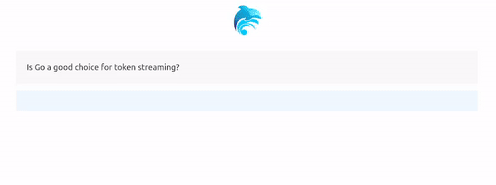Forwarding Tokens Through A Go Gateway
As mentioned above, adding a gateway between your model and your final client is important,
and Go is a good programming language for such an application. In production, you might also want to add a reverse
proxy between the Go gateway and the final client, and a load balancer between your Go gateway and your AI model in order
to spread the load on several replicas of your model. But it is out of the scope of our article!
Our Go application will also be in charge of rendering the final HTML page.
This application makes a request to the FastAPI app, receives the streamed tokens from FastAPI, and forwards each
token to the frontend using Server Sent Events (SSE). SSE is simpler than websockets because it is unidirectional. It
is a good choice when you want to build an application that pushes information to a client, without listening to a potential
client response.
Here is the Go code (the HTML/JS/CSS template will be showed in the next section):
package main
import (
"bufio"
"fmt"
"html/template"
"io"
"log"
"net/http"
"strings"
)
var (
templates *template.Template
streamedTextCh chan string
)
func init() {
// Parse all templates in the templates folder.
templates = template.Must(template.ParseGlob("templates/*.html"))
streamedTextCh = make(chan string)
}
// generateText calls FastAPI and returns every token received on the fly through
// a dedicated channel (streamedTextCh).
// If the EOF character is received from FastAPI, it means that text generation is over.
func generateText(streamedTextCh chan<- string) {
var buf io.Reader = nil
req, err := http.NewRequest("GET", "http://127.0.0.1:8000", buf)
if err != nil {
log.Fatal(err)
}
resp, err := http.DefaultClient.Do(req)
if err != nil {
log.Fatal(err)
}
defer resp.Body.Close()
reader := bufio.NewReader(resp.Body)
outerloop:
for {
chunk, err := reader.ReadBytes('\x00')
if err != nil {
if err == io.EOF {
break outerloop
}
log.Println(err)
break outerloop
}
output := string(chunk)
streamedTextCh <- output
}
}
// formatServerSentEvent creates a proper SSE compatible body.
// Server sent events need to follow a specific formatting that
// uses "event:" and "data:" prefixes.
func formatServerSentEvent(event, data string) (string, error) {
sb := strings.Builder{}
_, err := sb.WriteString(fmt.Sprintf("event: %s\n", event))
if err != nil {
return "", err
}
_, err = sb.WriteString(fmt.Sprintf("data: %v\n\n", data))
if err != nil {
return "", err
}
return sb.String(), nil
}
// generate is an infinite loop that waits for new tokens received
// from the streamedTextCh. Once a new token is received,
// it is automatically pushed to the frontend as a server sent event.
func generate(w http.ResponseWriter, r *http.Request) {
flusher, ok := w.(http.Flusher)
if !ok {
http.Error(w, "SSE not supported", http.StatusInternalServerError)
return
}
w.Header().Set("Content-Type", "text/event-stream")
for text := range streamedTextCh {
event, err := formatServerSentEvent("streamed-text", text)
if err != nil {
http.Error(w, "Cannot format SSE message", http.StatusInternalServerError)
return
}
_, err = fmt.Fprint(w, event)
if err != nil {
http.Error(w, "Cannot format SSE message", http.StatusInternalServerError)
return
}
flusher.Flush()
}
}
// start starts an asynchronous request to the AI engine.
func start(w http.ResponseWriter, r *http.Request) {
go generateText(streamedTextCh)
}
func home(w http.ResponseWriter, r *http.Request) {
if err := templates.ExecuteTemplate(w, "home.html", nil); err != nil {
log.Println(err.Error())
http.Error(w, "", http.StatusInternalServerError)
return
}
}
func main() {
http.HandleFunc("/generate", generate)
http.HandleFunc("/start", start).Methods("POST")
http.HandleFunc("/", home).Methods("GET")
log.Fatal(http.ListenAndServe(":8000", r))
}
Our "/home" page renders the HTML/CSS/JS page (showed later). The "/start" page receives a POST request from the
JS application that triggers a request to our AI model. And our "/generate" page returns the result to the JS app through server sent events.
Once the start() function receives a POST request from the frontend, it automatically creates a goroutine that will make a request
to our FastAPI app.
The generateText() function calls FastAPI and returns every token received on the fly through a dedicated channel (streamedTextCh).
If the EOF character is received from FastAPI, it means that text generation is over.
The generate() function is an infinite loop that waits for new tokens received from the streamedTextCh channel. Once a new token is received,
it is automatically pushed to the frontend as a server sent event. Server sent events need to follow a specific formatting that uses "event:" and "data:"
prefixes, hence the formatServerSentEvent() function.
In order for SSE to be complete, we need a Javascript client that is able to listen to server sent events by subscribing to the "generate" page.
See the next section to understand how to achieve that.

